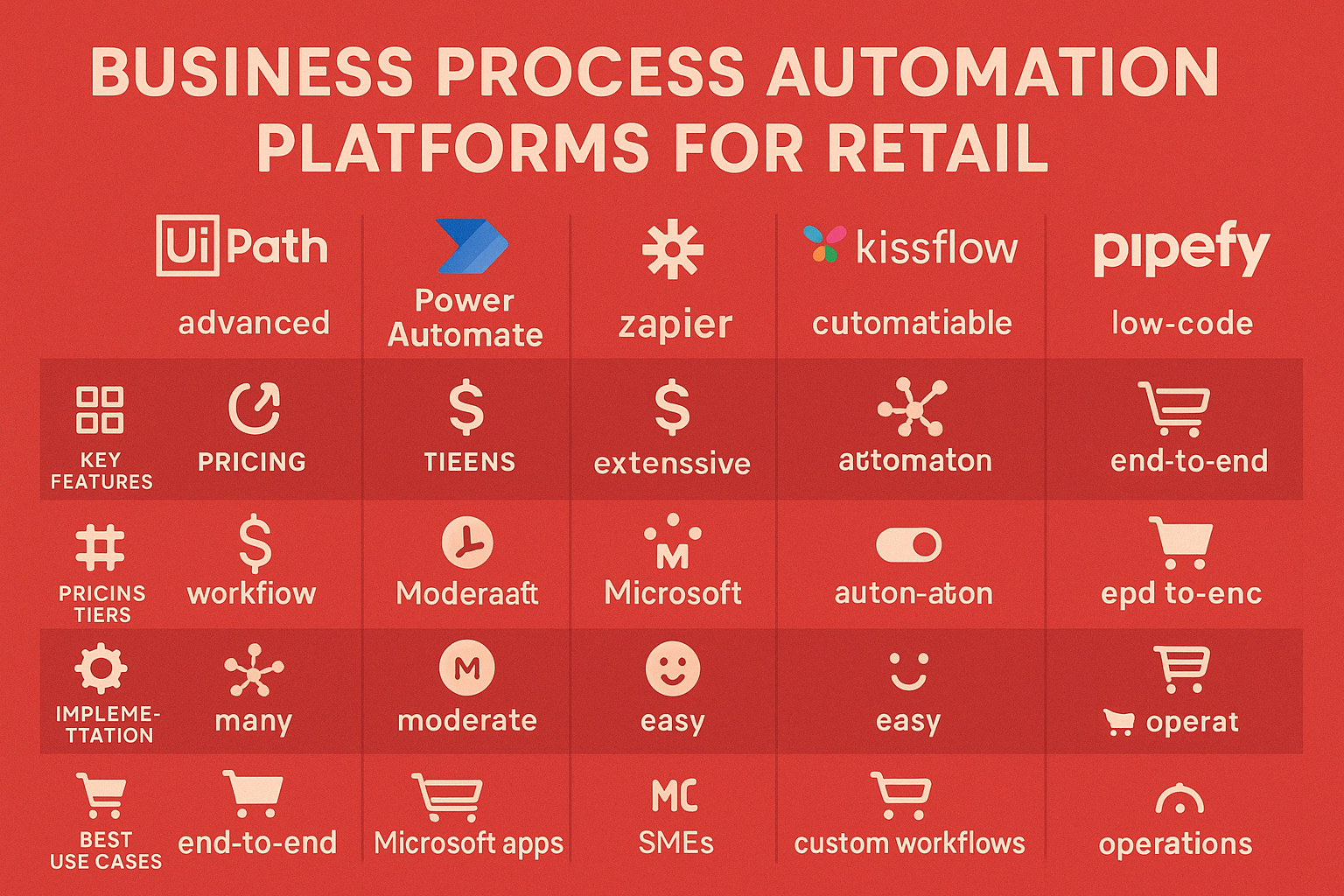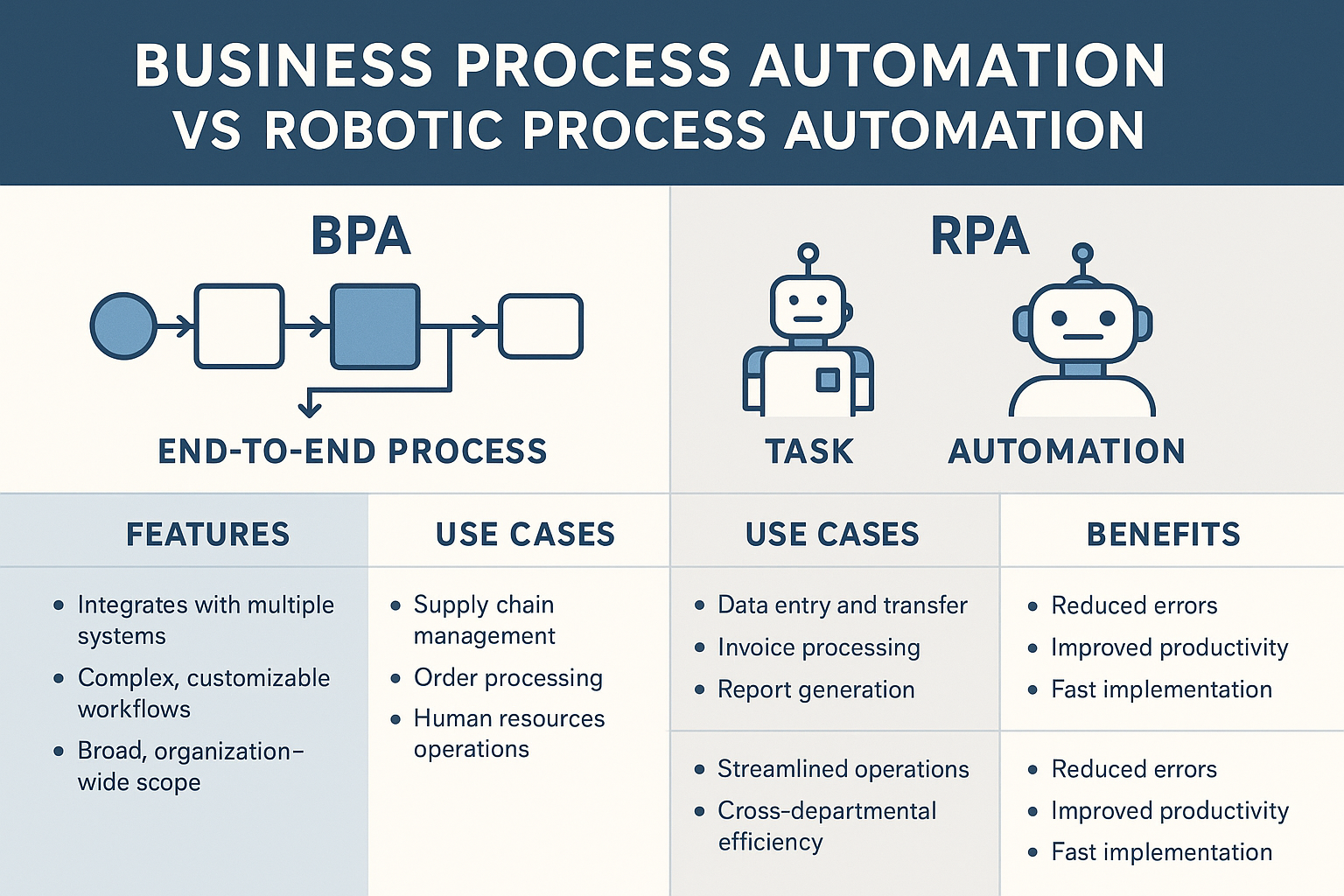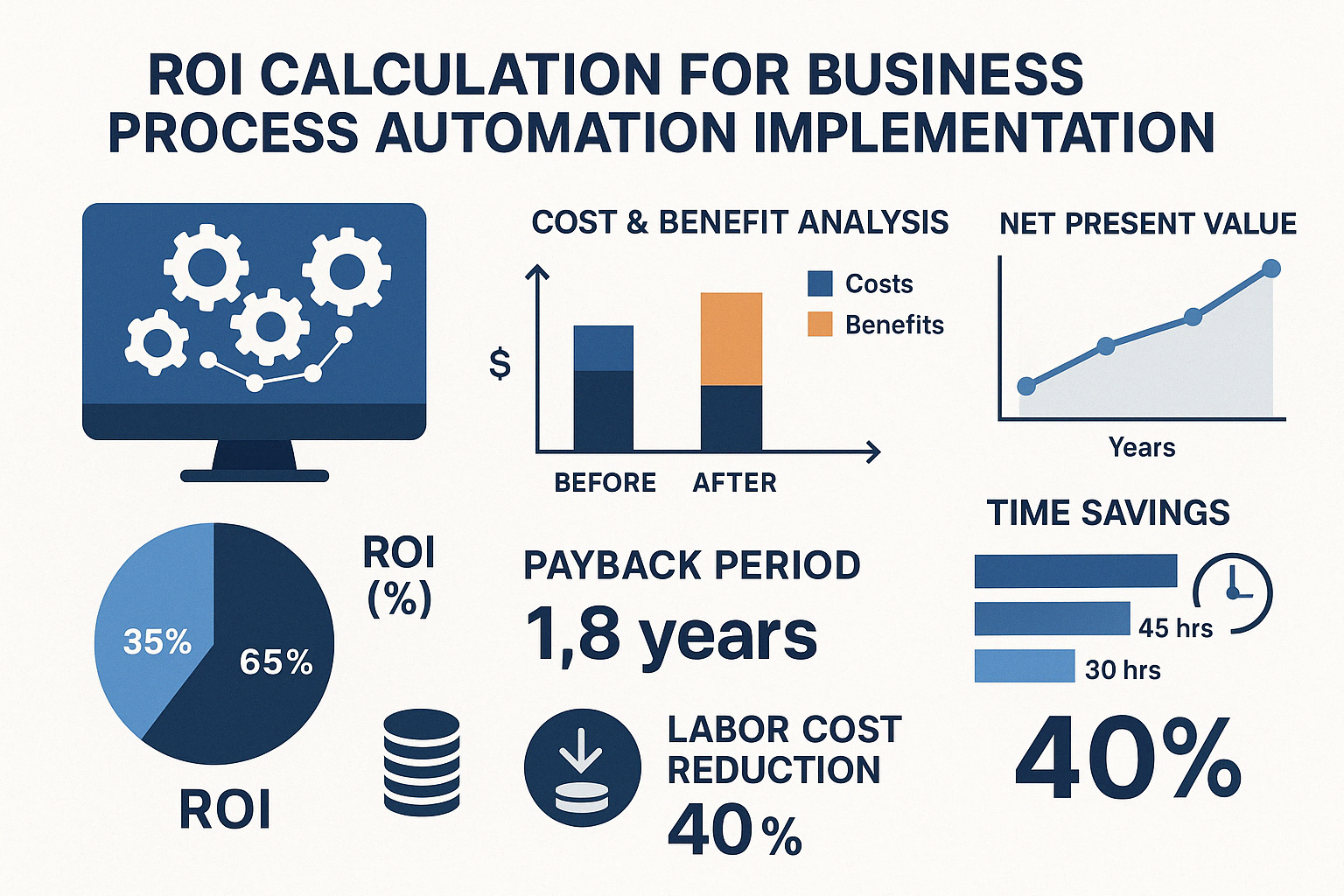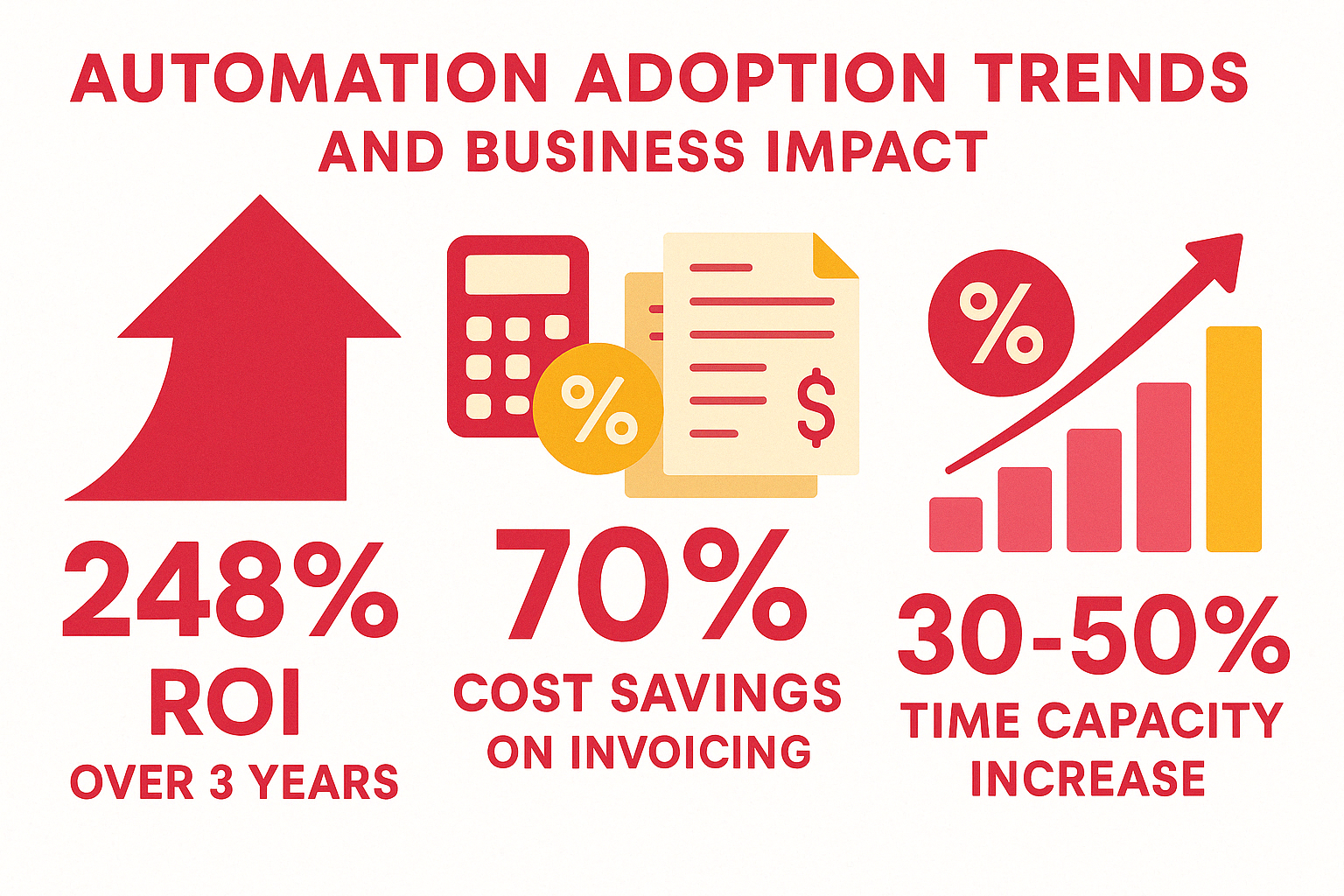Top Automation Platforms That’ll Make Your Business Processes Less Painful
| Platform | Best For | Key Features | Starting Price |
|---|---|---|---|
| Platform A | Enterprise | AI-powered, comprehensive | $420/year |
| Platform B | Microsoft users | 1000+ integrations | $15/month |
| Platform C | Small business | 7000+ app connections | Free plan available |
| Platform D | Non-technical users | No-code interface | $10/user/month |
| Platform E | Process management | Visual workflows | Free plan available |
In competitive business landscape, manual processes aren’t just tedious—they’re expensive. According to industry research, up to 80% of organizations will adopt intelligent automation by 2025, with good reason. Companies implementing business process automation report dramatic improvements: one financial institution reduced account opening time by 70%, while another increased lending volumes by 250% without additional hiring.
“Our team of three is able to perform like a team of 10,” shares Marcus Saito, Director of IT at a company that implemented automation for help desk requests.
For retail businesses specifically, automation can transform everything from inventory management to customer communications and employee onboarding. The right platform eliminates data entry errors, reduces operational costs, and creates a more responsive customer experience—all while empowering your existing staff rather than replacing them.
The key is finding a solution that matches your specific needs, technical capabilities, and existing systems.

Understanding Business Process Automation Platforms
Have you ever wished your business could run more smoothly, with less manual effort and fewer headaches? That’s exactly what business process automation platforms are designed to do. These powerful software solutions take all those repetitive, time-consuming tasks and transform them into streamlined digital workflows that practically run themselves.
Unlike basic software that might handle just one task at a time, business process automation platforms orchestrate entire workflows across your organization. They’re the conductors of your business symphony, connecting your people, applications, and systems into harmonious, efficient processes.
As Gartner puts it, BPA is “the automation of complex business processes and functions beyond conventional data manipulation and record-keeping activities, usually through the use of advanced technologies. It focuses on ‘run the business’ as opposed to ‘count the business’ types of automation efforts and often deals with event-driven, mission-critical, core processes.” In other words, these platforms handle the important stuff that keeps your business moving forward.
BPA vs. RPA: Understanding the Difference
When exploring automation options, you’ll likely encounter both BPA and RPA. Though they sound similar, they serve different purposes in your business toolkit:
Business Process Automation (BPA) is like redesigning your entire operation for maximum efficiency. It focuses on end-to-end workflow automation, orchestrating complete processes that might span multiple departments and systems. BPA is about changing how work flows through your organization from start to finish.
Robotic Process Automation (RPA), on the other hand, is more like hiring digital assistants to handle specific tasks. These software robots or “bots” mimic human actions to complete discrete jobs like data entry, file transfers, or form filling—the digital equivalent of having a tireless employee who works 24/7 without coffee breaks.
“Think of BPA as redesigning the highway system for better traffic flow, while RPA is like adding self-driving cars to the existing roads,” as one automation expert colorfully explains. “Both improve efficiency, but in fundamentally different ways.”
The good news is you don’t necessarily have to choose between them. Many modern solutions now blend elements of both approaches. A comprehensive business process automation platform might use RPA capabilities for specific tasks within a broader automated workflow. This powerful combination is part of what industry experts call “intelligent automation”—merging process automation with artificial intelligence and advanced analytics to create systems that not only follow rules but can actually learn and improve over time.

Key Features of Top Business Process Automation Platforms
When shopping for business process automation platforms, certain features make all the difference between a solution that simply works and one that truly transforms your business. These aren’t just fancy add-ons—they’re the core capabilities that determine how quickly you can implement automation and how well it will adapt as your business grows.
No-Code/Low-Code Capabilities in Business Process Automation Platforms
Remember when you needed a computer science degree to create anything digital? Those days are thankfully behind us. Today’s best business process automation platforms feature intuitive, drag-and-drop interfaces that anyone can use.
“Gone are the days of settling for rigid, one-size-fits-all solutions,” as one industry expert puts it. This democratization of technology means your marketing team can build their own approval workflows without camping out in the IT department.
These user-friendly platforms come with visual workflow builders that let you map out processes as easily as drawing a flowchart. They include form designers for creating digital versions of your paperwork without writing a single line of code. Many even offer pre-built templates for common business processes that you can customize to fit your specific needs.
One financial institution shared a success story that sounds simple but had huge impact: “We were able to appeal to our customers by making it easy to pay bills” after implementing a solution their team could quickly adapt as needs changed.
For smaller businesses without dedicated tech teams, this accessibility is game-changing. As one operations manager put it, “airSlate WorkFlow was easy to set up, and its templates are already set in a way that are more simple to use.”
AI and Machine Learning Integration in Business Process Automation Platforms
The automation platforms of yesterday just followed rules. Today’s intelligent solutions actually learn and adapt. Modern business process automation platforms now incorporate artificial intelligence that makes your automated processes smarter over time.
These AI capabilities aren’t just fancy tech—they deliver real results. Intelligent document processing can now “read” and extract data from even the messiest invoices or contracts. Predictive analytics help you spot potential bottlenecks before they happen. Natural language processing means your systems can understand customer requests without human translation. And decision engines can handle complex choices based on rules you define.
The impact is substantial: one healthcare provider cut report creation time by 95% after implementing AI-improved automation. A financial advisor noted, “We are seeing a major difference in accuracy, as the platform provides a >95% accuracy which has helped cut down our processing time by ~50%.”
This isn’t about replacing humans—it’s about letting AI handle the repetitive stuff so your team can focus on work that requires human judgment and creativity.
Integration with Existing Systems
The best automation doesn’t exist in a vacuum. Top business process automation platforms play nicely with your existing technology, connecting seamlessly with the tools your team already uses every day.
This connectivity is crucial because real business processes rarely stay within the boundaries of a single system. Your customer onboarding might touch your CRM, your billing system, your document storage, and your email platform—all of which need to share information.
Leading platforms offer pre-built connectors to popular business applications (some with over 1,000 ready-to-use integrations). They provide API integration kits for connecting to your custom or legacy systems. Database connectors give direct access to your information repositories, while web services support helps you link to cloud applications.
As one Accounts Payable representative finded, “Direct integration with our ERP system helped automate a crucial part of our Accounts Payable process.” This connection eliminated hours of manual data entry and reconciliation, dramatically reducing processing time and errors.
Process Intelligence and Analytics
You can’t improve what you can’t measure. The best business process automation platforms now include powerful analytics that show exactly how your processes are performing.
These insights come through features like process mining, which visualizes how work actually flows through your organization (often quite differently from how you think it does). Task mining identifies repetitive activities that are prime candidates for automation. Performance dashboards display key metrics like completion times and error rates, while bottleneck identification pinpoints exactly where things are getting stuck.
“Now staff (and managers!) cannot forget that something was needed,” shared one operations manager, highlighting how this increased visibility improved accountability and reduced delays throughout their organization.
This intelligence layer doesn’t just help you automate—it helps you optimize continuously, ensuring your automated processes keep delivering maximum value as your business evolves.

Benefits of Implementing a Business Process Automation Platform
When businesses adopt a business process automation platform, they open up a world of advantages that extend far beyond just saving time. These benefits ripple through the entire organization, creating lasting positive change in how work gets done.
Increased Efficiency and Productivity
Let’s face it – nobody wants to spend their workday doing tedious, repetitive tasks. Automation frees your team from this burden, often with remarkable results.
One restaurant chain we worked with eliminated a whopping 2,000 hours of manual work annually just by automating their daily sales and labor reporting. Imagine what your team could accomplish with that kind of time back in their day!
“The automation built into airSlate WorkFlow helped us remove many manual steps in our old process,” shared an operations manager at a biomedical organization. This isn’t just about doing things faster—it’s about giving your team the opportunity to focus on creative work that actually requires human intelligence and judgment.
Cost Savings and ROI
The financial impact of implementing a business process automation platform can be substantial and quick to realize. Organizations typically see their bank accounts benefit through reduced labor costs for routine tasks, fewer expensive errors needing correction, faster processing of revenue-generating activities, and reduced overhead from paper-based processes.
One user put it simply: “My ‘back of envelope’ guess is that I have increased my time capacity by 30-50% by automating common tasks, even taking into account the time to develop the automations.”
More formal research backs this up, showing organizations can achieve up to a 248% return on investment over three years. A product manager we worked with reported their solution “has been able to save 70% on invoicing costs, improve customer turnaround from over six hours to seconds, and free up staff from tedious work.”

Improved Accuracy and Compliance
We’re all human, and humans make mistakes. Unfortunately, in business, these errors can be costly both financially and to your reputation. Automation dramatically reduces these errors while making regulatory compliance simpler and more reliable.
When you implement a business process automation platform, you get standardized processes that follow defined rules every time, automated validation that catches data errors before they cause problems, complete audit trails of all activities, and consistent application of compliance requirements.
A registrar at a design institution told us, “Essentially, airSlate WorkFlow is paying for itself with the positive impact it has had on our workflow!” By removing manual data entry and ensuring business rules are applied consistently, automation significantly reduces your risk exposure.
Scalability and Adaptability
Perhaps the most powerful benefit of business process automation platforms is how they enable your organization to grow without proportionally increasing headcount or costs. This scalability is absolutely critical in today’s rapidly changing business landscape.
We helped one financial institution support 100,000 new vendors in under a month through automation—a scale that would have been impossible with manual processes. Similarly, BlueShore Financial achieved a 250% increase in lending volumes without additional hiring after implementing process automation.
As one technology services manager put it: “Our recurring costs are lower as we need less staff to get the same process done. The process is now a lot quicker, smoother and reliable.”
“As many as 80% of organizations will adopt intelligent automation by 2025,” according to recent industry research. This isn’t just a trend—it’s becoming a business necessity for companies that want to remain competitive.

By 2023, intelligent and smart RPA will successfully bridge the gap between automation silos…
How to Choose the Right Business Process Automation Platform
Selecting the ideal business process automation platform doesn’t have to feel overwhelming. Think of it like choosing a new car—you need to consider your specific needs, what you’ll use it for, and how it fits your lifestyle. Let’s walk through a practical approach to finding your perfect automation match.
Identify Automatable Processes
Before diving into platform features, take a step back and look at your business processes with fresh eyes. Which tasks are eating up your team’s valuable time? The best automation candidates typically share common traits.
Look for processes that involve high volumes of repetitive work—like data entry, form processing, or approval workflows. These tasks should follow consistent rules and patterns. As one business owner put it: “Automation works best when you’re dealing with the same headache over and over again.”
Start by mapping out how work currently flows through your organization. This exercise often reveals surprising inefficiencies. One operations manager finded their team was spending 15 hours weekly on manual report compilation that could be completely automated. “We were so used to the pain, we didn’t realize there was a better way,” they shared.
Automation works best with stable, mature processes. As one forum user wisely noted: “Determine the root cause of the repetitive task before choosing an automation tool. Sometimes what you need to fix is the process itself, not just automate the broken parts.”
Evaluate Key Features and Capabilities
When comparing business process automation platforms, think about who’ll be using the system and what they need to accomplish. Different tools shine in different scenarios.
If you have a team of non-technical users, prioritize platforms with intuitive, visual interfaces. The ability to drag and drop elements to build workflows can be a game-changer. As one department head shared, “Our team went from spectators to creators once we found a tool they could actually use without calling IT.”
For more complex environments, look at how the platform handles sophisticated orchestration. Can it manage conditional logic? Does it offer robust error handling? Will it scale as your processes grow more complex?
Consider whether AI capabilities matter for your specific needs. Intelligent document processing can transform how you handle invoices, contracts, and forms by automatically extracting data from unstructured documents. One accounting team reduced manual data entry by 85% using this technology.
Don’t forget about mobile support if your team works remotely or in the field. And always prioritize platforms with strong security and governance features—especially if you’re in a regulated industry.
Assess Integration Requirements
Most business processes don’t exist in isolation—they connect to multiple systems and data sources. Your automation platform needs to play nicely with your existing technology ecosystem.
Check whether the platform offers pre-built connectors to your critical applications. For example, if you rely heavily on Microsoft 365, Salesforce, or QuickBooks, look for platforms that offer seamless integration with these tools.
Consider the platform’s API capabilities for custom integrations with proprietary systems. As one IT director advised, “Leverage existing in-built or pre-installed tools to ensure broader compatibility across environments.” This approach saves significant development time and reduces technical debt.
Data change features are equally important—can the platform translate information between different formats and systems? This capability is essential when connecting modern cloud applications with legacy systems that speak different “languages.”
Calculate Return on Investment
Every business investment deserves careful financial consideration, and automation platforms are no exception. Building a solid ROI case helps secure buy-in and set realistic expectations.
Start with implementation costs, including software licensing, professional services, and training. Then identify tangible benefits like time savings, error reduction, and improved compliance. One operations director reported: “The solution saved us 70% on invoicing costs, improved customer turnaround from six hours to seconds, and freed up staff from tedious work.”
Don’t overlook the strategic value of automation. When team members spend less time on repetitive tasks, they can focus on work that drives innovation and customer satisfaction. One retail manager noted, “Our store associates now spend 30% more time with customers instead of paperwork—that’s a competitive advantage you can’t easily measure.”
Calculate both short-term gains and long-term benefits. While some platforms deliver quick wins, others provide more sustainable value through continuous improvement and scalability.
Consider Vendor Support and Community
The relationship with your automation provider matters just as much as the technology itself. Look beyond features to evaluate the ecosystem surrounding each platform.
Strong vendor support can make or break your automation journey. Research how quickly the provider responds to issues, what training resources they offer, and whether they provide implementation guidance. One Head of Accounts Payable shared, “I have built a relationship with the provider which now feels like they are part of our team.”
A vibrant user community offers invaluable peer support and inspiration. Active forums, user groups, and knowledge bases can accelerate your learning curve and help you find creative solutions to common challenges.
If you’re new to automation, consider vendors who offer implementation partners with experience in your industry. These specialists can help you avoid common pitfalls and achieve faster results.
At Smart Technologies of Florida, we’ve guided organizations through this selection process for 23 years. Our team believes that successful automation starts with understanding your people—their needs, challenges, and goals—before recommending technology solutions. The right platform should feel like it was made for your specific business, not force you to adapt to its limitations.
Smart Technologies of Florida: Your Partner in Business Process Automation
When it comes to automation, we’ve learned something important over our 23 years in business: the best technology in the world fails without people who know how to use it. At Smart Technologies of Florida, we’re not just tech implementers—we’re your neighbors in Daytona Beach who understand that real business change happens when people and technology work together.
Our People-Centric Approach to Automation
Think about the last time you tried to use a complicated new tool. Frustrating, right? That’s why we focus first on your team’s actual needs, not just flashy features of business process automation platforms.
We start with conversations, not software demos. Our process findy workshops help uncover which tasks are actually eating up your team’s valuable time. Then we design solutions that feel intuitive rather than intimidating.
“Through this tool, we have increased the quality of our work, and therefore improved our customer retention,” one client told us after their team acceptd—not just tolerated—their new automated workflow.
The difference is in how we support change. We don’t just install software and disappear. We provide training that makes sense, check in regularly, and make adjustments as your team provides feedback. Because automation that sits unused helps nobody.
Custom Digital Solutions for Your Unique Challenges
Your business isn’t cookie-cutter, so why should your automation be? We tailor business process automation platforms to fit your specific needs, not the other way around.
For instance, one client came to us frustrated with their employee onboarding process. Papers kept getting lost, and new hires spent their first week filling out forms instead of learning their jobs. We created a custom automated workflow that cut onboarding time by 60% while ensuring nothing fell through the cracks.
Another client struggled with purchase orders getting stuck waiting for approvals. Their vendors were getting paid late, creating tension in important relationships. Our solution streamlined approvals and notifications, turning a three-day process into something that happens in hours.
As the Head of Digital Projects at one client put it: “Now whenever we talk about processes the next word that comes into our mind is automation.” That’s the kind of change we love to see.
We’re platform-agnostic, meaning we recommend what works for your situation—not what gives us the biggest commission. Whether you need simple workflows or AI-powered intelligent automation, we match the solution to your actual needs and budget.
Ensuring Long-Term Success Through Strategic Change
Automation isn’t something you set and forget. It’s more like a garden that needs regular attention to truly flourish. That’s why we stick around after implementation to help you:
Keep measuring what matters so you can see your real ROI Spot new opportunities as your business grows and changes Adapt quickly when market conditions shift Build confidence in your team to manage and improve workflows themselves
One client’s Head of Digital Change summed it up perfectly: “It not only saves the employee hours, but also saves the customer hours, and that is what we call a success journey.”
With Smart Technologies of Florida as your partner, you’re not just getting technology—you’re gaining a team that cares about your success as much as you do. We’re in this for the long haul, helping you build automation that continues delivering value year after year.
Frequently Asked Questions about Business Process Automation Platforms
What is the difference between BPA and RPA?
When exploring automation options, you’ll often hear about both Business Process Automation (BPA) and Robotic Process Automation (RPA). Though they sound similar, they serve different purposes in your digital change journey.
Think of BPA as the architect of your automation strategy. It looks at the big picture, redesigning entire workflows across your organization to make them more efficient. BPA connects different departments, systems, and people into one seamless process.
RPA, on the other hand, is more like a digital employee who handles specific tasks. These software “robots” mimic human actions – clicking buttons, entering data, or transferring files between systems – just like your team members would.
“While BPA focuses on overall process automation and streamlining workflows, RPA targets specific repetitive tasks with software bots, and BPM (Business Process Management) is a broader approach to managing and optimizing complete business processes,” as one expert explains.
Many of our clients at Smart Technologies find the best results come from using both approaches together. RPA offers quick wins by automating repetitive tasks within your existing systems, while BPA provides the framework for comprehensive, long-term process improvement.
How can small businesses benefit from business process automation?
Small businesses often wonder if automation is worth the investment. The truth is, smaller organizations frequently see the most dramatic benefits from business process automation platforms, precisely because they have fewer resources to spare.
For small business owners, every hour saved through automation directly impacts the bottom line. One small business owner shared: “I once used DOS batch to automate 98% of my job,” demonstrating that even simple automation tools can deliver remarkable value.
The benefits for small businesses are particularly powerful:
Cost efficiency becomes a competitive advantage when you can grow without proportional increases in staffing. Your team of five can accomplish what used to require ten people.
Error reduction protects your reputation and bottom line. When your invoicing is automated, you’ll never accidentally bill a customer twice or miss a payment.
Customer service improves dramatically when automated systems handle routine inquiries, freeing your small team to address complex customer needs with personal attention.
Focus on growth becomes possible when you and your team aren’t bogged down in paperwork and manual processes. The time saved can be invested in sales, product development, and strategy.
Today’s cloud-based business process automation platforms offer affordable monthly subscriptions, making powerful automation accessible without large upfront investments. The no-code interfaces mean you don’t need to hire IT specialists to get started – perfect for resource-conscious small businesses.
What role does AI play in enhancing business process automation?
Artificial intelligence has transformed business process automation platforms from simple workflow tools into intelligent systems that can handle complex, judgment-based tasks. This evolution is making automation accessible for more sophisticated business processes.
AI brings a new level of intelligence to your automated processes. For example, instead of just routing an invoice through a predefined approval workflow, AI can actually “read” the invoice, extract the relevant information, check it against purchase orders, and flag discrepancies – all without human intervention.
One healthcare provider we worked with saw a 95% reduction in report creation time after implementing AI-powered document processing. Another client noted, “We are seeing a major difference in accuracy, as the platform provides a >95% accuracy which has helped cut down our processing time by ~50%.”
The most valuable AI capabilities in today’s automation platforms include:
Intelligent document processing that understands various document formats, even when they’re inconsistent. This is particularly valuable for processing vendor invoices, contracts, and customer correspondence.
Decision automation that learns from historical patterns to make or recommend decisions, like automatically approving expense reports that match previous legitimate expenses.
Natural language processing that understands customer emails or chat messages and can route them appropriately or even respond directly to common questions.
Industry analysts predict that “intelligent and smart RPA will successfully bridge the gap between automation silos, resulting in more seamless process automation and inter-departmental collaboration” by 2023. This integration of AI with automation is creating opportunities to automate even the most complex business processes.
How do I identify which processes to automate first?
Choosing the right starting point for automation can make the difference between a quick win that builds momentum and a challenging project that stalls. At Smart Technologies, we help clients identify their best automation candidates by looking for these key characteristics:
High volume processes give you the biggest return on your automation investment. If your team processes hundreds of customer orders daily, automating even part of that workflow delivers significant time savings.
Repetitive, rule-based tasks are the easiest to automate successfully. If the process follows clear, consistent rules with predictable decision points, it’s ideal for automation.
Error-prone activities cost you in both time and customer satisfaction. One client was spending hours each week correcting data entry errors in their customer records – automation eliminated those errors entirely.
Cross-departmental workflows often have significant delays at handoff points. When a customer order moves from sales to fulfillment to billing, automation can eliminate the waiting time between each step.
Customer-facing processes directly impact your reputation. Automating appointment scheduling or order status updates can dramatically improve customer experience while reducing staff workload.
“Analyze your workflow to identify tasks that are repetitive and stable enough for automation,” advised one of our automation experts. We typically recommend starting with a process that’s important but not mission-critical. This builds your team’s confidence and expertise before tackling more complex projects.
What are the implementation challenges of business process automation?
While the benefits of automation are compelling, it’s important to approach implementation with eyes wide open. Understanding common challenges helps you prepare for a smoother transition.
Process standardization is often the first hurdle. Before you can automate a process, you need clear agreement on how it should work. We often find undocumented “tribal knowledge” or different approaches across teams that need to be harmonized before automation.
Data quality issues can undermine even the best automation. As one client finded, their customer database had inconsistent formatting and duplicate records that needed cleaning before their new automated marketing process could work properly.
Integration complexity varies widely depending on your existing systems. Modern applications with APIs are relatively straightforward to connect, while legacy systems may require more creative approaches.
Change management is perhaps the most underestimated challenge. Your team may worry that automation threatens their jobs, or they may simply prefer familiar ways of working. Clear communication about how automation will make their work more valuable (not eliminate it) is essential.
Governance and maintenance needs ongoing attention. Automated processes aren’t “set and forget” – they require monitoring and updates as your business evolves.

“Balance the time investment needed to develop an automation process against the expected time savings,” recommended one of our implementation specialists. This practical advice highlights why we help clients select automation targets carefully, focusing on processes where the return justifies the investment.
Successful implementations typically involve cross-functional teams with both technical and business process expertise. We’ve found that a phased approach works best – deliver quick wins to build momentum while developing the foundation for more comprehensive automation.
Conclusion
The landscape of business process automation platforms continues to evolve rapidly, with AI and low-code capabilities making automation more accessible and powerful than ever before. As we’ve seen throughout this article, organizations of all sizes are achieving remarkable efficiency gains, cost savings, and competitive advantages through thoughtful automation.
The results speak volumes about automation’s impact. TD Ameritrade slashed their account opening time by 70%. BlueShore Financial boosted lending volumes by an impressive 250% without hiring additional staff. And countless small businesses have completely transformed how they operate through smart automation solutions.
As one IT Director so perfectly put it: “Our team of three is able to perform like a team of 10.” This isn’t just about doing more with less—it’s about empowering your people to focus on what truly matters while technology handles the routine tasks.
At Smart Technologies of Florida, we’ve spent 23 years helping businesses in Daytona Beach and beyond achieve these kinds of transformative results. We don’t just implement technology; we guide you through the entire automation journey with our people-centric approach. From identifying your highest-value opportunities to creating custom solutions that actually fit your business, we’re committed to ensuring your long-term success.
The truth is, the future belongs to organizations that find the right balance between human expertise and digital automation. When you free your team from repetitive, manual tasks, you open up their potential to focus on innovation, building customer relationships, and driving strategic initiatives that fuel growth.
Are you ready to make your business processes less painful? Contact us today to explore how we can help identify and implement the right automation solutions for your unique needs. Let’s transform your operations together.












